Xin Q. Diesel Engine System Design
Подождите немного. Документ загружается.

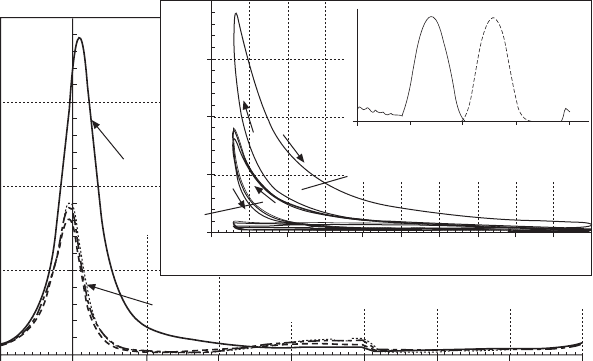
438 Diesel engine system design
© Woodhead Publishing Limited, 2011
hot gas recirculated from the exhaust manifold during engine retarding in
order to provide higher retarding power. It is essentially an ‘internal EGR’
technology used in the retarding operation. As shown earlier in Fig. 6.7 in
the discussions on the exhaust brake, the engine inherently generates several
exhaust pressure pulses in the exhaust port. These pulses try to open the
exhaust valve during the intake or compression stroke to ow the exhaust
gas into the cylinder. BGR utilizes this phenomenon. In BGR, the braking
valve is opened in late intake stroke until the early part of the compression
stroke to induct the hot exhaust gas into the cylinder via a pressure differential
between the exhaust port pressure pulse and the in-cylinder pressure. The
braking valve lift event for BGR can be generated by any of the following: a
mechanical cam, a bleeder event, a VVA device, or by the exhaust-pressure-
pulse-induced free motion of the braking valve such as in the case of the
exhaust-pulse-induced brake. The BGR valve lift event is sometimes also
called a ‘secondary lift’ in braking. BGR can help increase the turbocharger
speed and achieve high peak cylinder pressure. In the open literature, the
BGR concept has not been fully explored, and its mechanism has not been
clearly explained. The BGR theory is developed as follows.
High peak cylinder pressure is the key for high retarding power. The
following factors can increase the cylinder pressure: high engine compression
ratio, high intake manifold boost pressure, and a large amount of gas mass
trapped in the cylinder during the compression stroke. The boost pressure
is related to turbocharger operation. The trapped gas mass is related to the
–90 0 90 180 270 360 450 540 630
Crank angle (degrees)
Compression-release engine
brake at different engine speeds
Cylinder pressure (bar, absolute)
200
150
100
50
0
Firing
Positive power
Negative
power
Exhaust
brake
valve
Intake
valve
0 180 360 540 720
Crank angle
Valve lift
Cylinder pressure (bar, absolute)
200
150
100
50
0
0 0.1 0.2 0.3 0.4 0.5 0.6 0.7 0.8 0.9 1
Instantaneous cylinder volume/maximum cylinder volume
6.15 The engine cycle process of compression-release brake.
Diesel-Xin-06.indd 438 5/5/11 11:50:34 AM
439Engine brake performance in diesel engine system design
© Woodhead Publishing Limited, 2011
valve events used in each stroke and the associated reverse ows (if any)
as well as the engine volumetric efciency. The intake boost pressure can
be increased by many design measures (e.g., using higher turbocharger
efciency or a smaller turbine area such as a VGT, or reducing the turbine
outlet pressure). One important and effective method of boosting the ow is
to increase the turbine inlet temperature. Higher exhaust energy or exhaust
manifold gas temperature received by the turbine can increase the turbine
speed to deliver high intake boost pressure. The key issue is where to obtain
this high exhaust temperature for the turbine. BGR conducts an ‘exhaust gas
recovery’ to harvest the hot exhaust gas mass back into the cylinder, and
compresses the hot charge by the piston to even hotter at the TDC, and release
it to the turbine. Note that the hot exhaust mass is essentially originated from
the moving vehicle’s kinetic or potential energy during the braking process
when the engine brake works like an air compressor. Transferring this energy
from the vehicle to the turbine inlet to speed up the turbine is inherently a
very efcient mechanism. With the blow-down process this hot exhaust gas
is fed into the turbine as high pressure and high temperature pulse energy
ow to increase the turbocharger speed. As a consequence, the boost pressure
becomes higher, and the cylinder charge is compressed to an even higher
temperature. Such a compounding effect continues until the entire charging
process reaches an equilibrium condition (e.g., steady state). The key enabler
for this highly effective cylinder-pressure building process is BGR. A higher
BGR valve lift event with appropriate BGR valve timing will increase the
retarding power signicantly. Analysis and experimental work have shown
that BGR can increase the retarding power of the compression brakes to
extremely high (i.e., much higher than the ring rated power), provided the
high cylinder pressure does not create structural design or stress problems on
the braking components (depending on the type of the compression brakes).
In summary, any efcient compression brake design should be directed toward
the two important fundamental braking mechanisms: the compression-release
process, and the BGR process.
For four-stroke engines, the right BGR valve lift location is the crank
angle durations in the late intake stroke and the early compression stroke
where the intake valve is almost closed and the exhaust port pressure is
higher than the in-cylinder pressure (i.e., around 500–600° after the ring
TDC). For different engines (I4, I6, with divided or undivided turbine entry or
exhaust manifold) and at different speeds, the exhaust port pressure pulsation
pattern can be different. The optimum BGR valve lift location can change
accordingly.
Engine air ow rate affects the in-cylinder gas temperature and the
exhaust manifold gas temperature. In general, the lower the air ow rate, the
higher the temperatures. A large air ow rate is desirable in engine braking
because it cools the cylinder head components, the injector nozzle tip and
Diesel-Xin-06.indd 439 5/5/11 11:50:34 AM
440 Diesel engine system design
© Woodhead Publishing Limited, 2011
the exhaust manifold for better durability. It should be noted that increasing
the turbine outlet pressure causes a reduction in the turbine power and the
air ow rate.
Also note that because the air ow rate is high in BGR operation, the
increased exhaust manifold gas temperature is usually still below the
allowable temperature limit. In fact, it can be lower than the high exhaust
temperatures encountered in the exhaust brake operation where the air ow
is choked. The air ow rate and the boost pressure are related via the engine
volumetric efciency. It should be noted the engine volumetric efciency
in compression braking with BGR becomes complex due to the change in
the valve events, compared to the case in ring operation. Considering the
requirements on both retarding power and component thermal durability,
a good design objective for compression brake design can be stated as to
achieve simultaneous high engine air ow rate and high exhaust manifold
temperature within the design constraints. BGR is the mechanism to
achieve this goal in a balanced manner. The ultimate retarding power limit
is bounded by allowable peak cylinder pressure and exhaust manifold gas
temperature.
Turbocharger matching for engine braking
Turbocharged diesel engines have different retarding power capability
compared to the naturally aspirated diesel engines owing to their different
levels of peak cylinder pressure and engine delta P. The engine delta P is
governed mainly by turbine area and engine air ow rate. The volumetric
efciency is related to valve events. It should be noted that a xed-geometry
turbine or a wastegated turbine selected for good ring operation is usually
inferior to a VGT for good retarding power capability. Therefore, both ring
and retarding operations need to be considered in engine air system design
and turbocharger selection/matching.
Figure 6.16 illustrates the engine breathing characteristics and turbocharger
matching. It shows that if the engine volumetric efciency can be altered
by valve events, the turbocharging performance in engine braking can be
adjusted for a specic brake design purpose. It also shows an illustration
of the methods of improving engine retarding power relative to the critical
parameter – the engine delta P. The engine delta P is not only related to the
pumping loss and retarding power, but also to the design constraints such
as exhaust valve oating, the exhaust valve spring preload, and the exhaust
manifold pressure. Different design strategies, either low or high engine delta
P, can be selected in engine brake designs. Figure 6.17 summarizes the root
causes and the corresponding design solutions for the common problems
related to compression brake performance.
Diesel-Xin-06.indd 440 5/5/11 11:50:34 AM
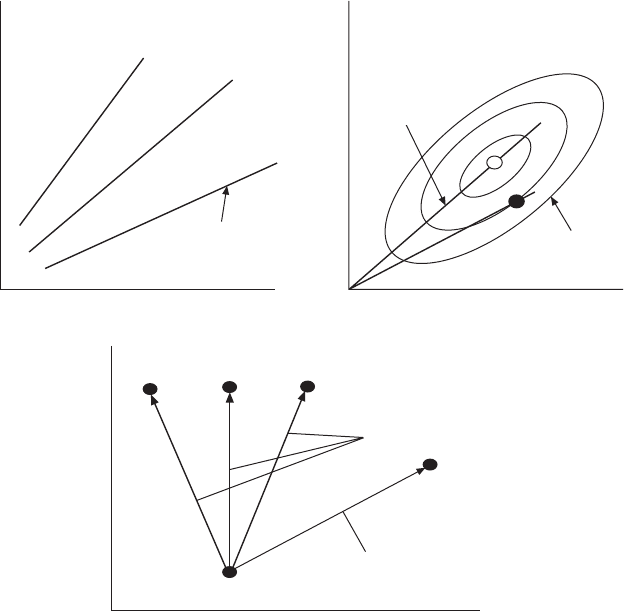
441Engine brake performance in diesel engine system design
© Woodhead Publishing Limited, 2011
Summary of key design principles for compression brakes
The key elements in a powerful compression brake are summarized as
below:
∑ Achieve high intake manifold boost pressure and peak cylinder pressure.
This ensures a powerful compression-release process and a high air
ow.
∑ Do not throttle turbine outlet at high engine speeds where the turbine
pressure ratio should be much greater than 1. This ensures a high turbine
speed with a large pressure ratio to deliver high intake boost pressure.
∑ Use BGR. The retarding power of the conventional compression brake
is usually limited by the peak cylinder pressure that can be sustained
by the maximum allowable braking cam stress, while the exhaust-pulse
compression brake does not have such a cam stress limit because its
Engine volumetric efficiency
Engine retarding power
Compressor pressure ratio
Naturally aspirated engine, intake
manifold pressure is approximately
equal to ambient pressure
Engine breathing
characteristic line at
different speeds
Rely on strong
compression-release effect
to increase retarding power
Compressor
efficiency
contours
Turbocharged engine, intake
manifold pressure is higher
than ambient pressure
Engine air flow rate Engine air flow rate
Engine delta P
(exhaust manifold pressure minus intake manifold pressure)
The slope is roughly
the reciprocal of
volumetric
efficiency
Rely on high engine delta P and
pumping loss to increase retarding
power
Higher volumetric
efficiency by
valve timing
Lower
volumetric
efficiency
6.16 The principle of compression-release engine brake.
Diesel-Xin-06.indd 441 5/5/11 11:50:34 AM
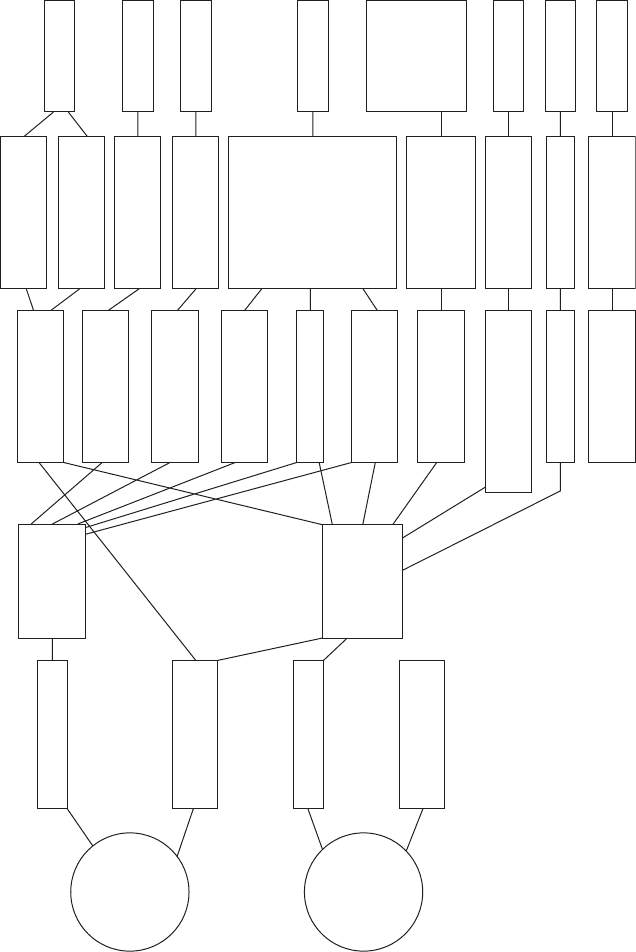
© Woodhead Publishing Limited, 2011
Low
retarding
power
Low
engine
delta P
Low boost
pressure, low
turbine power
Excessively
high
injector tip
temperature
Low pumping loss
Low air flow rate
Root cause
High potential
Low potential
High potential
High potential
High potential
High potential
High potential
Replaced by
modulating
turbine area or
entry or a valve
at turbine inlet
Ineffective brake
valve lift profile
Better valve actuation
for higher brake lift
Reduce EGR valve or
wastegate leakage
use divided turbine
entry
Raise design limit
of engine delta
P by 1–2 bar and
reduce turbine
area by VGT or
block one entry
in twin-entry or
install a valve at
the turbine inlet
Design better
hydraulics/mechanism
EGR valve or turbine
wastegate leakage
undivided turbine
entry
Engine delta P
design limit too low
Large turbine area
Low turbine inlet
pressure
High turbine outlet
pressure
Low turbo efficiency
(e.g., compressor choke)
Design solution Effect on
retarding power
Injector temperature
design limit too low
Low compression-
release effect
Turbocharger lag
Reduce turbo lag
High heat losses in
exhaust manifold
Delete or fully
open turbine outlet
exhaust flap valve
Change turbo
aerodynamic design
Increase turbine
inlet temperature
6.17 Logic flowchart of engine brake performance problems and design solutions.
Diesel-Xin-06.indd 442 5/5/11 11:50:34 AM
443Engine brake performance in diesel engine system design
© Woodhead Publishing Limited, 2011
braking valve lift is generated by the exhaust pressure pulses. Moreover,
the exhaust-pulse brake naturally achieves the BGR effect. The maximum
lift of the BGR event in the conventional brake is limited by the peak
cylinder pressure. The exhaust-pulse brake does not have this limit and
is more advanced. The key to make the exhaust-pulse brake successful
is to produce all the braking valve lift events by throttling the turbine
inlet rather than the turbine outlet. Because both the intake boost
pressure and engine delta P can be high in the exhaust-pulse brake, the
resulting required high exhaust manifold pressure should be managed
carefully.
∑ Generate a braking valve lift prole around the braking TDC and a
BGR valve lift with a cost-effective design without the excessive design
constraints of braking cam stress due to the peak cylinder pressure.
The above theory illustrates that, when turbocharger matching and valvetrain
design are conducted, the requirements from engine braking performance also
need to be considered. It is emphasized again that the engine performance
design must be integrated as a whole system, not only because of the
complex interactions between different subsystems, but also for the purpose
of coordinating the needs of different applications.
6.4.3 Performance characteristics of compression
brakes
The retarding power of compression brakes is sensitive to many design and
operating factors including engine speed, total engine displacement in braking
(or the number of cylinders), engine compression ratio, braking valve effective
ow area, braking valve lift/timing/duration, and turbine area.
The optimum braking valve effective ow area for the maximum retarding
power may vary with the engine speed. Usually, a high engine speed and
a large air ow rate demand a large valve ow area. Using one valve in
braking can reduce the gas load acting on the braking components (e.g.,
the injector, the exhaust pushrod and cam). In order to provide a sufcient
braking valve ow area, one-valve braking needs to have basically twice the
valve lift used in two-valve braking, thus demanding a larger valve-to-piston
clearance. One-valve braking and two-valve braking designs are elaborated
by Price and Meistrick (1983).
The optimum braking valve opening timing also depends on the engine
speed. The optimum timing occurs earlier at higher speeds in order to assure
adequate blow-down of the cylinder charge. Figure 6.18 presents the simulation
results by using GT-POWER for a conventional compression brake with
one-valve braking for an I6 heavy-duty diesel engine. The optimum closing
timing (i.e., re-set timing) of the braking valve after the TDC following the
Diesel-Xin-06.indd 443 5/5/11 11:50:34 AM

© Woodhead Publishing Limited, 2011
Valve lift (mm)
Cylinder pressure (bar, absolute)
12
11
10
9
8
7
6
5
4
3
2
1
0
150
100
50
0
120
110
100
90
80
70
60
50
40
30
20
10
0
–90 0 90 180 270 360 450 540 630
Crank angle (degree)
–90 0 90 180 270 360 450 540 630
Crank angle (degree)
BVo = –40 deg
BVo = –20 deg
BVo = 0 deg
BVo = 20 deg
Engine retarding power (hp)
Engine retarding power (hp) or
engine air flow rate (lb/min)
400
300
200
100
0
–60 –50 –40 –30 –20 –10 0 10 20 30 40
BVo timing (degree crank angle)
–60 –50 –40 –30 –20 –10 0 10 20 30 40
BVo timing (degree crank angle)
VGT vane
opening
= 0.5
VGT vane
opening
= 0.65
VGT vane
opening
= 0.75
VGT vane
opening
= 1.0
VGT vane
opening
= 0.5
VGT vane
opening
= 0.65
VGT vane
opening
= 0.75
VGT vane
opening
= 1.0
Retarding power
Air flow rate
6.18 Conventional compression brake performance sensitivity at 2100 rpm with one-valve braking.
Diesel-Xin-06.indd 444 5/5/11 11:50:35 AM
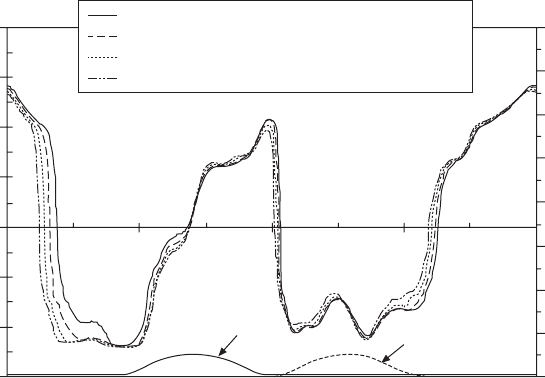
445Engine brake performance in diesel engine system design
© Woodhead Publishing Limited, 2011
blow-down may yield an additional gain in retarding power because closing
the valve as the piston moves down in the expansion stroke may minimize the
cylinder pressure (see Fig. 6.19 for the illustration of the instantaneous valve
ows in a bleeder brake simulation). Figure 6.20 presents a comprehensive
simulation analysis on the effect of bleeder valve lift, turbine-out ap valve
opening, VGT area, and engine speed for a bleeder brake. This analysis
also reveals the interaction between the compression brake and the exhaust
brake.
Superior low-speed retarding torque has been a design challenge. From a
vehicle drivability point of view, running at 1500 rpm instead of 2100 rpm
during braking is probably easier for the driver because down-shifting is
not needed. Low-speed braking can also reduce compression brake noise.
Using VGT, BGR or a turbine-inlet exhaust brake may help increase the
low-speed torque. At very low engine speeds where the turbine pressure
ratio is low or close to 1, a turbine-outlet exhaust brake can be considered.
Note again that the throttling effects at the turbine inlet and outlet with an
exhaust brake are fundamentally different. Throttling the turbine inlet does
not affect the turbine pressure ratio or the turbine speed as drastically as
throttling the turbine outlet where the effect of increased exhaust restriction
is produced. A careful design balance between the brake, the engine, and
the turbocharger is required in order to fulll all the design requirements.
The retarding performance of different compression brakes combined with a
variable exhaust brake is discussed by Hu et al. (1997b). More information
Air velocity at bleeder valve (m/s), lift 0.02 inch
Air velocity at bleeder valve (m/s), lift 0.03 inch
Air velocity at bleeder valve (m/s), lift 0.04 inch
Air velocity at bleeder valve (m/s), lift 0.05 inch
0 180 360 540 720
Exhaust bleeder
braking valve lift
Intake valve lift
Crank angle (degree)
Exhaust flow velocity (m/s)
800
600
400
200
0
–200
–400
–600
160
140
120
100
80
60
40
20
0
Valve lift (mm)
6.19 Illustration of braking exhaust valve flow velocity in bleeder
brake at 2100 rpm.
Diesel-Xin-06.indd 445 5/5/11 11:50:35 AM
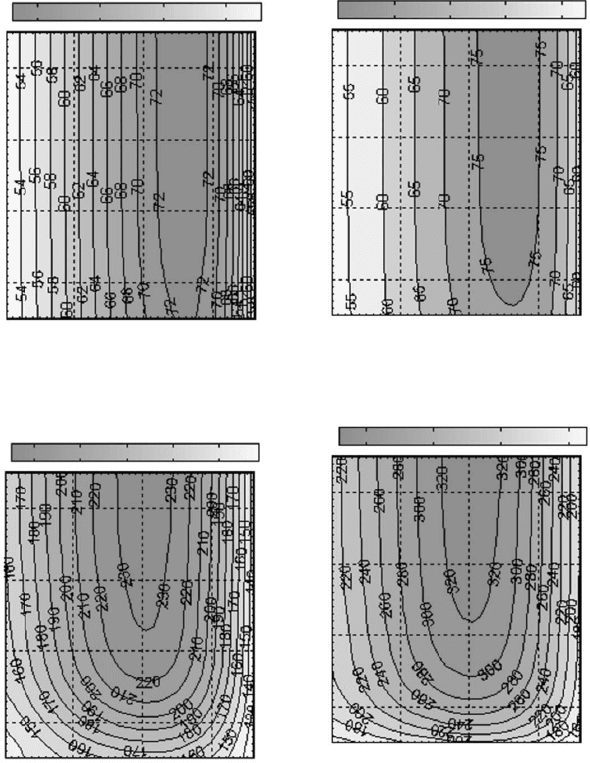
© Woodhead Publishing Limited, 2011
dkfgope
dkfgope
1.5
1.5
20 40 60 80
Exhaust flap opening (degree)
20 40 60 80
Exhaust flap opening (degree)
20 40 60 80
Exhaust flap opening (degree)
20 40 60 80
Exhaust flap opening (degree)
Bleeder braking performance with VGT area = 570 mm
2
Bleeder braking performance with VGT area = 700 mm
2
Retarding power (hp) 2800 rpm
Retarding power (hp) 2800 rpm
Retarding power (hp) 1800 rpm
Retarding power (hp) 1800 rpm
Exhaust bleeder valve lift in bleeder
braking (mm)
Exhaust bleeder valve lift in bleeder
braking (mm)
Exhaust bleeder valve lift in bleeder
braking (mm)
Exhaust bleeder valve lift in bleeder
braking (mm)
2
1.5
1
0.5
2
1.5
1
0.5
2
1.5
1
0.5
2
1.5
1
0.5
220
200
180
160
140
300
250
200
150
70
65
60
55
75
70
65
60
55
6.20 Engine bleeder brake
performance sensitivity to
the effects of bleeder lift,
turbine-outlet exhaust flap
valve, engine speed, and
VGT opening area.
Diesel-Xin-06.indd 446 5/5/11 11:50:35 AM
447Engine brake performance in diesel engine system design
© Woodhead Publishing Limited, 2011
on the design effects on braking performance is provided by Schmitz et al.
(1992) and Imai et al. (1996).
A detailed comparison between engine motoring, the conventional
compression brake and the bleeder brake on their instantaneous working
processes within an engine cycle is illustrated in Fig. 6.21. The corresponding
steady-state performance data are shown in Table 6.1. This example shows
that engine cycle simulation plays a very powerful role in understanding the
principles of the engine brakes.
6.4.4 Design constraints of compression brakes
The key durability design constraints of the compression brake are summarized
as follows. These design limits need to be examined carefully.
∑ Peak cylinder gas pressure, which affects engine structural durability.
∑ In-cylinder component metal temperature, for example the injector nozzle
tip temperature. The temperature of the injector tip during engine braking
is very different from that during the ring operation where a supply
of fuel ow to the injector provides a cooling effect. The injector tip
temperature depends directly on the in-cylinder heat ux, which is affected
by the engine air ow rate and the compressor boost pressure.
∑ Exhaust manifold gas temperature, which is affected by BGR and engine
air ow rate, which is in turn inuenced by the turbocharger performance
and the exhaust braking valve opening at the turbine outlet (if any).
∑ Valvetrain gas loading and component stress. These include the gas
loading from the peak cylinder pressure near the braking TDC acting on
the braking valve, the pushrod, and the cam. The braking load and the
stress on the cam and the rocker arm may exceed the valvetrain loading
capability in the ring operation. The loading on the valve system in
the compression brake is discussed by Imai et al. (1996).
∑ Engine delta P. This limit is evaluated to prevent excessive exhaust valve
oating. It is related to the exhaust spring preload and the associated
exhaust cam stress.
∑ Braking house stress and structural/hydraulic compliance.
∑ Coolant heat rejection. Although the heat rejection of the compression
brakes is far less than that of a hydrodynamic retarder, the coolant
heat rejection may become signicant at very high retarding power. It
is necessary to check the heat rejection to ensure a sufcient cooling
capacity.
∑ All other common design constraints that should be considered in the
engine system design for ring operation, for example turbocharger
speed, compressor outlet air temperature, etc.
Diesel-Xin-06.indd 447 5/5/11 11:50:35 AM
